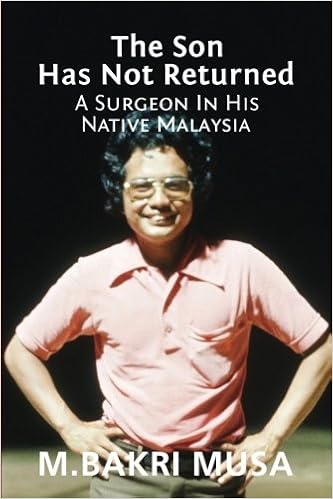Better and Cheaper Alternatives To GLCs
M. Bakri Musa
The overall performance of these GLCs,
especially with respect to their primary mission of spearheading Malay
participation in commerce, is underwhelming. It is time to abandon this
expensive and ineffective strategy.
These GLCs
have acquired powerful constituencies. As such it would be a monumental political
undertaking to dismantle these GLCs. If we were to have these GLCs then I would
prefer that they be modeled after such American entities as the giant utility
Tennessee Valley Authority (TVA), financing arm Export-Import (Ex-Im) Bank, or the
space agency NASA. These companies undertake major and expensive ventures with
their associated unquantifiable risks that cannot be borne by private entities.
The need for GLCs in those areas can thus be better justified.
Consider NASA.
The potential gains from its missions are long term, if at all realized. NASA’s
research is literally out of this world with both the risks and costs
unquantifiable and thus difficult to justify to shareholders. Yet we have seen
the tangible benefits (aside from the moon landing and space exploration
generally) in many seemingly unrelated fields such as manufacturing in zero gravity
environments and elemental diets in clinical medicine.
Likewise with
TVA; the tremendous boost in farm productivity and overall improvement in
living conditions in America’s rural heartland owe much to the massive rural
electrification programs made possible through TVA. Ex-Im Bank finances exports
ranging from Boeing jets to Iowa wheat.
I would have also
included Freddie Mac and Fannie Mae to the list of American GLCs except for
their recent abysmal if not criminal performances. Both were instrumental in
creating the housing bubble 2007 that triggered the worst economic crisis in
America since the Great Depression. Theirs is a noble mission–to increase home
ownership among the poor and minority groups long ignored by banks and mortgage
companies.
Alas, noble
mission alone is no guarantee of success or it being subverted. Both
corporations aggressively pursued their mission and enjoyed robust profits. As
it turned out those profits were used to lobby congressmen and regulators so the
companies could skirt around existing regulations. In America, acts otherwise
considered outright corruption and influence peddling in any other jurisdiction
are viewed as legitimate pursuits of democratic rights! The excesses of Freddie
Mac and Fannie Mae helped burst the American real estate bubble that in turn
greased the slide into America’s worst recession.
There is
however, one major difference with the way the Americans handled their GLC fiascoes
as compared to Malaysians. Those debacles were subjected to intense public
scrutiny through congressional hearings and criminal prosecutions. The shenanigans
of the major culprits were exposed and they were held accountable. By contrast,
to date Malaysians still do not know the extent, costs, or persons responsible
for such spectacular failures like the Bank Bumiputra bankruptcy. As we do not
examine our mistakes, we never learn from them. Malaysians are condemned to
repeat them and at a much higher scale and cost. The Malaysian learning curve
with respect to GLCs is depressingly flat. The current 1MDB debacle differs
from previous ones only in scale, specifically the magnitude as well as
audacity of the greed, and thus the cost.
The concept of
GLC is legitimate. There are as many models as there are countries. I am supportive
of China’s version. I do not mean the old communist state enterprises under Mao
where they were known more for their bloated workforce, low productivity, and
shoddy products. Those GLCs were meant to keep the masses employed, or more
correctly, occupied.
The new GLCs of
the post-Deng era have radically different missions, more along America’s TVA
and NASA, to undertake massive commercial ventures that are beyond the capacity
of China’s existing private sector. As China’s embrace of capitalism is recent,
its private sector is not as yet robust; hence the need for GLCs. Chinese GLCs
are also more focused, concentrating on three areas: civil engineering
(including solar energy), high technology, and biotechnology.
The second
mission of Chinese GLCs is to take on multinational corporations. China had to
move quickly as they were entering the country at an exceptionally fast pace,
thanks to Deng’s economic liberalization and the enticement of a huge untapped market.
The company Lenovo that bought IBM’s personal computer unit is an example of this
modern Chinese GLC.
With China
allowing and encouraging foreign companies to enter its market, there was (still
is) a stampede by them to establish beachheads. While the Chinese are
supporting their GLCs either directly or indirectly, WTO rules notwithstanding,
what they are not doing is limiting
the entry of these foreign companies. Chinese GLCs are thus forced to compete
with these multinationals.
For Malaysia,
the obvious fields where it has a definite competitive advantage, and thus a
good place to establish these GLCs, would be in such areas as rubber, palm oil,
wood products, and our old-world rainforest biodiversity. This would also be a
way for our GLCs to expand the market for local products. Consider the
potential for natural rubber. The biggest market is of course car tires. Here
the competition is from synthetic rubber but with the price of oil ever rising,
natural rubber could prove competitive. The niche and highly profitable market
however, would be in tires for jet planes, earth-moving equipment, and heavy
trucks where the resilience of natural rubber is superior. Additionally, rubber
is being used as shock absorbers for buildings in earthquake-prone areas.
Similarly
there could be downstream manufacturing and marketing of palm oil and wood
products. Currently FELDA is involved mainly in plantations with little
downstream activities. At the moment it concentrates on selling raw palm oil in
bulk to China and elsewhere instead of exporting the final products. Again we
see this with lumber; we still export raw logs instead of the finished
products. Engineered wood products are finding ever increasing use in
construction. So far there is little interest in the private sector to engage
in these R&D and manufacturing activities, hence the need for GLCs to
spearhead them.
Malaysia should
no longer export tin, rubber, or lumber; instead only their finished or manufactured
products. The GLCs should focus on those activities. What Malaysian GLCs should
not engage in is direct competition
with established private sector industries. I see no merit in having a GLC in
airlines, hotels, or hospitals. The Malaysian private sector is doing well in
these arenas; there is no need for the government to interfere.
Sell off
Malaysia Airlines. If AirAsia feels that Malaysia Airlines would complement it,
then be prepared to pay a premium for that, lest risking losing Malaysia
Airlines to another bidder. I have no problem if the airline were to be sold to
Singapore Airlines, Air Timbuktu, or whoever else willing to pay the best price.
There is only
one justification for GLCs like Malaysia Airlines and Pernas Hotels. That is,
to serve as training grounds for Malays. Thus Malaysia Airlines should be
training pilots, cabin crew, aircraft mechanics, and ground personnel in such
numbers that it becomes a net supplier to other companies in the industry,
regionally and globally. Similarly, those GLCs with hotel subsidiaries should
be the practical training grounds in preparing Malays for the hospitality
industry.
Back in
the1960s and 70s, these GLCs functioned precisely as that. Many budding young
Malays cut their executive teeth in these GLCs and were then poached by
multinationals and other major employers. That contributed towards fulfilling
the mission of increasing Bumiputra participation in the corporate sector. It
was also a tacit recognition of the value of their experiences with these GLCs.
Today it would
be a rare scenario to see any “poaching” of young executives from GLCs into the
private sector. It is even rarer to see a GLC executive leaving the company to start
his or her own enterprises. That more than anything else reflects the caliber and
value of their experience, which in turn tells us volumes about these
companies.
I see no merit
in having GLCs in sectors already well represented by local players. That would
be redundant and serve only to “crowd out” legitimate local enterprises.
Next: Transforming GLCs
Adapted from the author’s book, Liberating
The Malay Mind, published by ZI Publications, Petaling Jaya, 2013.
The second edition was released in January 2016.




